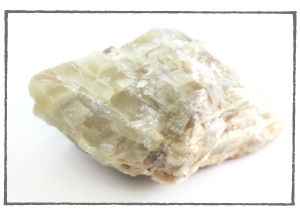MOONSTONE

MOONSTONE IS THE COMMON NAME for two species of feld-spar. Adularia moonstone is within the subgroup of orthoclase feldspar, and most specimens come from Sri Lanka, Burma, India, and Brazil. Albite moonstone (named for the feldspar subgroup albite) is also mined in Sri Lanka and India, as well as in Canada and Kenya. While albite moonstone is much rarer than adularia, both kinds have similar coloring and adularescence (a white to pale blue sheen of reflected light—also called the Schiller effect).
Though moonstone has been set in jewelry for thousands of years, including fine examples from both Asia and ancient Rome, it has been most closely associated with female energies. Symbolizing the moon, a celestial body connected to women throughout mythological history, it was a powerful talisman used by the High Priestesses of goddess-based worship cultures. It is thought to solidify one’s relationship with the Great Mother and has been used in efforts to ensure a healthy pregnancy, ease the labor of childbirth, and increase a new mother’s milk flow. In India, moonstone remains a most honored and mystical gem. Lovers often exchange the stone as a symbol of their affections, and it was once believed that placing a moonstone in your mouth under a full moon would reveal your true love. Moonstone is the ayurvedic birthstone for September and is considered a secondary or alternative birthstone for June.